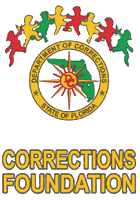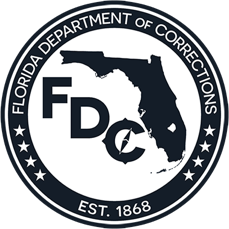2000
OFFENDER POPULATION JUNE 30, 2000
INMATES: 71,233
SUPERVISED: 149,470
INMATES: 71,233
SUPERVISED: 149,470
Under the continuing leadership of Governor Jeb Bush and Secretary Michael W. Moore, the Department of Corrections is currently the fourth largest prison system in the nation.
On January 1, 2000, indoor smoking is banned in Florida prisons for all but Death Row inmates. Inmates are still allowed to smoke outside.
![]() Florida becomes the first to place records and photos on the Internet for supervised offenders when the Supervised Population Information Search is launched February 14, 2000.
Florida becomes the first to place records and photos on the Internet for supervised offenders when the Supervised Population Information Search is launched February 14, 2000.
Terry Sims becomes the first inmate to die by lethal injection on February 23, 2000.
There are no escapes from the secure perimeter of a Florida prison during the fiscal year (July 1, 2000 to June 30, 2001). The decline in escapes is attributed to four factors: a zero tolerance policy for escapes; the implementation of a comprehensive security audit program that emphasizes practice over paperwork; replacing and upgrading perimeter barriers including fences and additional razor wire; and the installation of electronic perimeter detection systems.
The average percentage of sentence served by inmates released as of June 30 is 80.9%.
Over 4,000 Correctional Probation Officers and staff supervise more than 149,000 offenders. Correctional Probation Officers collect the following fees from offenders, when applicable: cost of supervision fees, victim restitution and court fines and costs. Payments collected during FY 1999-2000 total $83,252,503. Correctional Probation Officers also conduct more than 200,000 investigations each year, including pre- and post-sentence investigations.
![]() The Absconder/Fugitive Information Search web application is launched in December. It places absconder records on the Internet and provides the public an opportunity to assist with locating offenders who have ceased to make themselves available for supervision.
The Absconder/Fugitive Information Search web application is launched in December. It places absconder records on the Internet and provides the public an opportunity to assist with locating offenders who have ceased to make themselves available for supervision.
 The Corrections Foundation gives $36,288 to numerous FDC employees for emergency assistance. Types of family emergencies include: death of an employee, their spouse or
one of their children, a devastating illness or other emergency of an
employee, their spouse or one of their children, or the loss of a home due
to a fire.
The Corrections Foundation gives $36,288 to numerous FDC employees for emergency assistance. Types of family emergencies include: death of an employee, their spouse or
one of their children, a devastating illness or other emergency of an
employee, their spouse or one of their children, or the loss of a home due
to a fire.
2001
OFFENDER POPULATION JUNE 30, 2001
INMATES: 72,007
SUPERVISED: 152,018
INMATES: 72,007
SUPERVISED: 152,018
An Absconder unit is added to community corrections in January 2001. Its purpose is to locate offenders who have absconded from supervision and arrange for their capture and return to their court of original jurisdiction. In less than a year, almost 10,000 of the 48,298 absconders are located.
Over 3,780 Correctional Probation Officers and staff supervise more than 152,000 offenders. Correctional Probation Officers collect the following fees from offenders, when applicable: cost of supervision fees, victim restitution and court fines and costs. Correctional Probation Officers also conduct more than 275,000 investigations each year, including pre- and post-sentence investigations, violation investigations and other state investigations.
From January 1994 to June 2001, responsibility for preparing sentencing guidelines and Criminal Punishment Code scoresheets was shared between the Department's Probation and Parole Office and the State Attorney's Office (SAO), though the SAO prepared the majority of them. Beginning July 2001, the responsibility was placed solely with the SAO. The scoresheet, which numerically scores the level of the offender's crime, is used at the offender's sentencing and is sent to the Clerk of the Court to be made part of the official record. A copy of the official scoresheet is then sent to the local Parole & Probation offices to be entered into SAGES (the scoresheet database). That data is used to create reports on compliance, trends, etc.
Florida Department of Corrections Secretary Michael W. Moore presents a $16,500 check to the American Red Cross to assist with disaster relief efforts in New York City and Washington D.C. The money collected is the result of a one-day fund raiser sponsored by the Corrections Foundation, Inc. DOC employees from across the state donated money for the families and victims of the September 11th disaster.
Wexford Health Sources, Inc., is awarded a five-year contract to privatize health services in Region IV, which includes Charlotte, Desoto, Hendry, Hardee and Okeechobee correctional institutions in the "west cluster" and Everglades, Glades, Dade, Martin, Indian River, South Florida Reception Center and Broward correctional institutions in the "east cluster." Total capacity in both clusters is almost 18,000 inmates.
The Department privatizes its food service operations. The five year contract is awarded to two companies: Trinity Services Group, which provides food to Charlotte, Dade, Everglades and Polk correctional institutions, and Aramark Correctional Services, which serves the remaining institutions. Projected expenditures for its first year (FY 2001-2002) are $ 57.1 million.
The average percentage of sentence served by inmates released as of June 30 is 82.8%, its highest to date.
The Corrections Foundation gives $119,598 to numerous FDC employees for emergency assistance.
2002
OFFENDER POPULATION JUNE 30, 2002
INMATES: 73,553
SUPERVISED: 153,447
INMATES: 73,553
SUPERVISED: 153,447
The Department of Corrections is awarded more than $22 million through a federal grant program to help offset costs for housing criminal aliens, bringing to $151 million the amount received since 1994.
Wakulla Work Camp opens. It houses male inmates nearing the end of their sentences. One dormitory houses inmates who assist heartworm-positive dogs through the healing process and then obedience-train them. Once the dogs complete obedience training, they are returned to the Tallahassee Animal Services Center for adoption. The inmates, in turn, learn a valuable job skill.
 In 2002, the Corrections Foundation provides emergency financial assistance to 156 FDC employees totaling $268,400. Currently, 9,832 of the FDC's approximately 25,000 employees are members of the Corrections Foundation.
In 2002, the Corrections Foundation provides emergency financial assistance to 156 FDC employees totaling $268,400. Currently, 9,832 of the FDC's approximately 25,000 employees are members of the Corrections Foundation.
A total of 7,525 FDC employees contribute $362,943 to the 2002 Florida State Employees' Charitable Campaign. This money is earmarked for the needy in communities throughout not just Florida, but the world. The Florida State Employees' Charitable Campaign (FSECC) is the only combined fund-raising drive that receives official state coordination and support. The FSECC provides an organized and effective method for employees to donate to the charities of their choice, either through payroll deduction or a one-time gift. Employees are encouraged to choose which charity they wish their gift to go to, including United Way charities, national and international organizations and unaffiliated or independent charities.
U.S. SUPREME COURT RULES ON DEATH PENALTY ISSUES
In a 6-3 ruling on June 20, 2002, the United States Supreme Court bans the death penalty for mentally retarded inmates, saying that such executions are unconstitutionally cruel. They leave it to each state to define what constitutes mental retardation. In Florida, one must test below 70 on an I.Q. test to be defined as mentally retarded.
A few days later, the U.S. Supreme Court rules in a 7-2 vote that a jury, not a judge, must decide whether a defendant gets the death penalty. In the past, some Florida judges have overruled juries in death cases and imposed the death penalty. Florida, which has 370 inmates on death row at the time of the ruling, has fewer than 10 death row cases that could be affected by this ruling.
Howard Troxler, a columnist for the St. Petersburg Times, has this to say of the decisions in his June 26, 2002 column:
"Opponents of the death penalty are cheered by these rulings. Some even suggest they show a movement by the court away from the death penalty. But it might be a little too early to ice the champagne. It looks just as much like fine tuning by the court, a clearing of the decks as peripheral objections are resolved and removed one by one."
In June, the SAS Institute, a leader in business intelligence, presented their 11th Annual Enterprise Intelligence Award for government to the Florida Department of Corrections for excellence in data warehousing technology. The Enterprise Intelligence Award recognizes organizations that best demonstrate the use of SAS software to achieve business goals and maximize return on investment. The article congratulates the department on its efficient use of statistical analysis software in producing accurate and informative criminal justice data.

Dr. Bill Bales, Chief of the Department's Research and Data Analysis Bureau, is featured on the cover of SASCom magazine because his Bureau was awarded the 2002 SAS Enterprise Intelligence award for public sector agencies.
FEMALE SERIAL KILLER EXECUTED
Aileen Wuornos, nicknamed the "Highway Hooker," was executed Wednesday, October 10, at 9:30 am at Florida State Prison by lethal injection. Considered one of the nation's few female serial killers, Wuornos was just the third woman to die by execution in Florida. She confessed to killing and robbing seven men. Her story was the subject of several books, two documentaries, a television movie and an opera.
FDC employees earn five awards and $4,000 in the 2002 Davis Productivity Awards competition, and 19 others earned certificates of commendation, commemorative plaques or honorable mention. The Davis Productivity Awards were created to recognize and reward state employees whose work significantly and measurably increases productivity and saves money for Florida taxpayers and businesses.
 Florida's FDC web site wins the USA Today Hotsite Award for the second time. The first was in 1998 and recognized our online databases.
Florida's FDC web site wins the USA Today Hotsite Award for the second time. The first was in 1998 and recognized our online databases.
- 1821-1845
- 1868-1876
- 1877-1895
- 1900-1919
- 1921
- 1922-1924
- 1927
- 1928-1931
- 1932 | CHAPMAN
- 1933-1935
- 1936-1939
- 1940-1945
- 1946-1949
- 1950-1955
- 1956-1961
- 1962 | WAINWRIGHT
- 1963-1965
- 1966-1969
- 1970-1975
- 1976-1979
- 1980-1986
- 1987 | DUGGER
- 1988-1990
- 1991 | SINGLETARY
- 1992-1995
- 1996-1998
- 1999 | MOORE
- 2000-2002
- 2003 | CROSBY
- 2004-2005
- 2006 | MCDONOUGH
- 2007
- 2008 | MCNEIL
- 2009-2010
- 2011 | BUSS
- 2011 | TUCKER
- 2012 | CREWS
- 2013-2014
- 2014 | JONES
- 2015-2018
- 2019 | INCH
- 2020-2021
- 2021 | DIXON
- 2022-Today
- Population Summary Table



